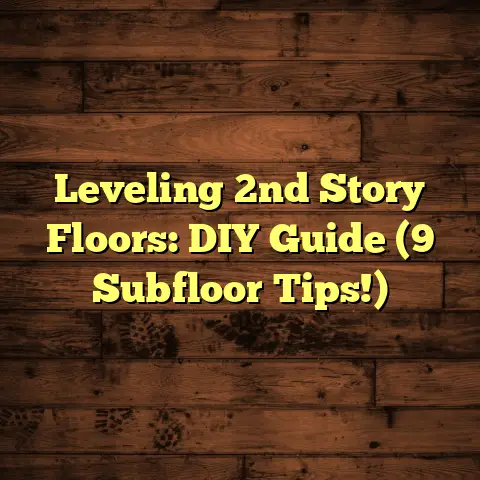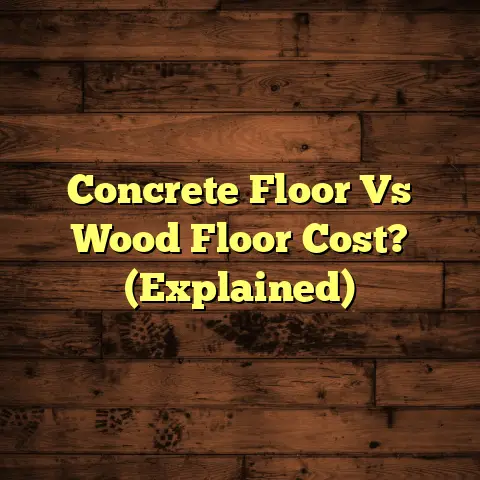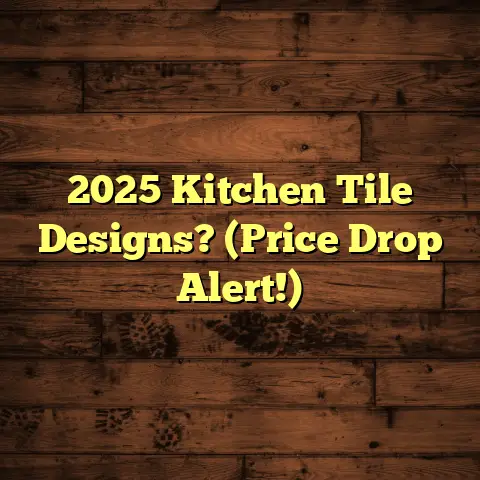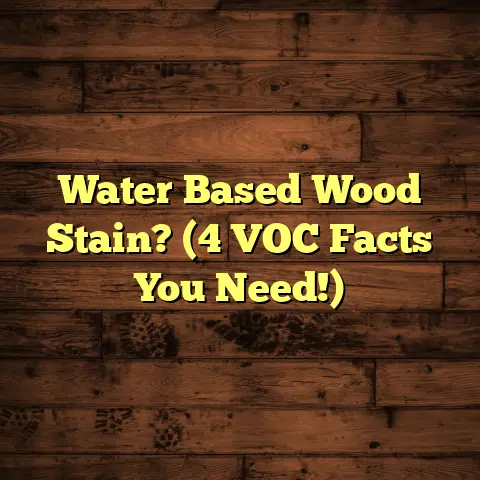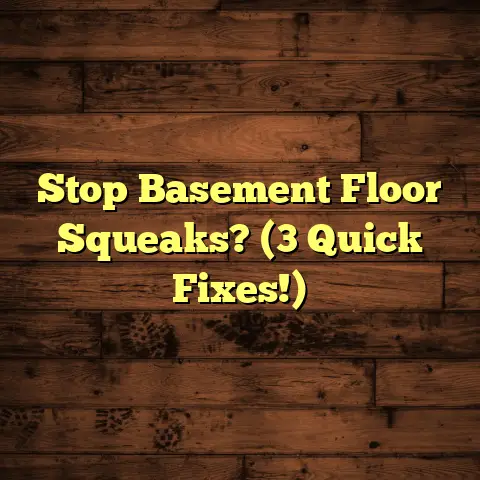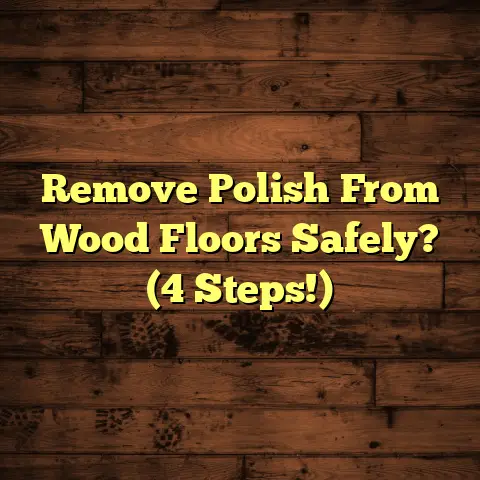Hardwood Vs. LVP Cost? (7 Factors To Consider!)
Are you ready to invest in your home’s flooring, but torn between the timeless elegance of hardwood and the modern practicality of Luxury Vinyl Plank (LVP)?
Flooring is more than just something to walk on. It’s the foundation of your home’s aesthetic. It impacts the comfort, and significantly influences property value.
Think about it: the right flooring can make a room feel warmer, larger, or more luxurious.
Two contenders consistently top the list for homeowners and investors alike: hardwood and Luxury Vinyl Plank (LVP).
Hardwood, with its natural beauty and classic appeal, has been a long-standing favorite. But LVP, with its durability and water resistance, is rapidly gaining popularity.
So, what’s the deal? Which one is right for you?
This isn’t just about picking the prettiest option. It’s about making a smart investment.
In this article, I’ll delve into the cost comparison. We’ll also look at other crucial factors that influence the decision between hardwood and LVP flooring.
I’ll break down everything from initial costs to long-term maintenance, resale value, and even environmental impact.
Let’s get started!
Section 1: Initial Costs
Alright, let’s talk money. When you’re staring at samples and dreaming of new floors, the first thing on your mind is likely the upfront cost.
What’s it going to actually cost to get this stuff installed?
First, let’s define what I mean by “upfront costs.” This includes the cost of the materials themselves and the labor to install them.
For hardwood flooring, you’re generally looking at a higher price tag upfront.
- Material Costs: Typically range from $8 to $15+ per square foot for solid hardwood, depending on the species (oak, maple, walnut, etc.), grade, and finish.
- Installation Costs: Professional installation can add another $4 to $8 per square foot, depending on the complexity of the job and your location.
So, for a 500 square foot room, you might be looking at $6,000 to $11,500+ installed.
Now, let’s consider LVP flooring. This is where things get interesting.
- Material Costs: Generally range from $3 to $7 per square foot, depending on the thickness, wear layer, and quality of the product.
- Installation Costs: Professional installation can range from $2 to $5 per square foot, but LVP is often DIY-friendly, which can save you money.
For that same 500 square foot room, you could be looking at $2,500 to $6,000 installed.
See the difference? LVP can be significantly cheaper upfront.
Variations in Cost:
Keep in mind that these are just averages. Several factors can influence the final cost:
- Quality: Higher-quality hardwood with exotic species or intricate patterns will cost more. Similarly, thicker LVP with a robust wear layer will command a higher price.
- Brand: Some brands are simply more expensive due to their reputation, design, or manufacturing processes.
- Geographical Location: Labor costs can vary significantly depending on where you live. Big cities usually mean higher labor costs.
Real-World Examples:
I recently worked on two similar projects that highlight these differences.
- Project A (Hardwood): A homeowner in a historic district chose solid oak hardwood for their living room. The total cost, including materials and professional installation, came to $9,000 for 600 square feet.
- Project B (LVP): Another homeowner in a suburban area opted for LVP in their basement. They chose a mid-range product and installed it themselves, bringing the total cost to $2,400 for 600 square feet.
The difference was staggering!
Key Takeaway:
LVP generally offers a lower initial cost compared to hardwood. However, remember that quality matters.
Cheaper LVP might not last as long or look as good as a higher-end product.
Section 2: Lifespan and Durability
Okay, you’ve got the initial costs in mind. But what about the long haul? How long will these floors actually last?
This is where lifespan and durability come into play.
Hardwood Flooring:
Hardwood is known for its longevity. Properly maintained, it can last for decades, even centuries!
- Average Lifespan: 25 to 100+ years, depending on the species, thickness, and how well it’s cared for.
Think about those beautiful hardwood floors in old Victorian homes. They’ve stood the test of time!
However, hardwood isn’t invincible.
-
Factors Affecting Durability:
- Foot Traffic: High-traffic areas will wear down the finish over time.
- Climate: Hardwood can expand and contract with changes in humidity, leading to warping or cracking.
- Maintenance: Neglecting regular cleaning and refinishing can shorten its lifespan.
- Moisture: Spills and leaks can cause serious damage if not addressed quickly.
- Pets: Scratches from pets can damage the finish.
LVP Flooring:
LVP is designed for durability and resilience. It’s a champion in high-traffic areas and moisture-prone environments.
- Average Lifespan: 10 to 25 years, depending on the quality and wear layer thickness.
While it might not last as long as hardwood, it’s still a solid investment.
-
Factors Affecting Durability:
- Wear Layer Thickness: This is the protective top layer that resists scratches and scuffs. The thicker the wear layer, the more durable the LVP.
- Quality of Manufacturing: Higher-quality LVP is more resistant to dents and damage.
- Subfloor Preparation: A properly prepared subfloor is crucial for LVP’s longevity.
- Sunlight Exposure: Prolonged exposure to direct sunlight can cause fading in some LVP products.
Statistics and Studies:
According to a study by the North American Laminate Flooring Association (NALFA), high-quality laminate flooring (which is similar in construction to LVP) can withstand up to 1,000 cycles of abrasion testing before showing significant wear.
This demonstrates LVP’s ability to stand up to everyday wear and tear.
Repair Costs:
- Hardwood: Scratches can be sanded and refinished. More significant damage might require replacing individual boards. Refinishing an entire hardwood floor can cost $3 to $8 per square foot.
- LVP: Minor scratches might be repairable with a touch-up kit. More significant damage usually requires replacing the affected plank(s). This is relatively easy and inexpensive, especially if you have extra planks on hand.
Key Takeaway:
Hardwood has a longer potential lifespan, but it requires more care and is more susceptible to damage from moisture and climate changes.
LVP is more durable and resistant to everyday wear and tear, but it won’t last as long as properly maintained hardwood.
Section 3: Maintenance Costs
Now, let’s talk about the ongoing care your floors will need.
Maintenance costs can add up over time, so it’s important to factor them into your decision.
Hardwood Flooring:
Hardwood requires consistent maintenance to keep it looking its best.
-
Cleaning Protocols:
- Regular sweeping or vacuuming to remove dirt and debris.
- Damp mopping with a pH-neutral hardwood floor cleaner.
- Avoiding excessive water or harsh chemicals.
- Using rugs in high-traffic areas to protect the finish.
-
Refinishing:
- Hardwood floors will eventually need to be refinished to remove scratches and restore the finish.
- This typically needs to be done every 7-10 years, depending on the amount of traffic.
- Refinishing can be a significant expense, costing $3 to $8 per square foot.
-
Annual Maintenance Costs:
- Cleaning supplies: $50-$100 per year.
- Professional cleaning (optional): $100-$300 per year.
- Refinishing (every 7-10 years): $3 to $8 per square foot.
LVP Flooring:
LVP is known for its low-maintenance nature.
-
Cleaning Protocols:
- Regular sweeping or vacuuming to remove dirt and debris.
- Damp mopping with a mild detergent.
- LVP is water-resistant, so spills are less of a concern (but still clean them up promptly!).
-
Resilience:
- LVP is highly resistant to scratches, stains, and fading.
- It doesn’t require refinishing.
-
Annual Maintenance Costs:
- Cleaning supplies: $20-$50 per year.
- That’s it!
Expert Opinions and Testimonials:
I spoke with a homeowner who had both hardwood and LVP in their home.
They said, “The hardwood is beautiful, but it’s definitely more work. I’m constantly worried about scratches and water spills. The LVP in the basement is so easy to care for. I just mop it every week, and it looks great.”
Key Takeaway:
LVP is significantly easier and cheaper to maintain than hardwood.
If you’re looking for a low-maintenance flooring option, LVP is the clear winner.
Section 4: Installation Costs
Let’s dive into the nitty-gritty of installation. This is where things can get tricky, and costs can vary widely.
Hardwood Flooring:
Hardwood installation is generally more complex and requires specialized skills.
-
Installation Process:
- Subfloor Preparation: The subfloor must be level and dry.
- Acclimation: Hardwood needs to acclimate to the room’s temperature and humidity for several days before installation.
- Nailing or Gluing: Solid hardwood is typically nailed or glued to the subfloor.
- Sanding and Finishing: After installation, the floor may need to be sanded and finished.
-
Professional Installation:
- Professional installation is highly recommended for hardwood.
- Improper installation can lead to problems like warping, cupping, or gapping.
- Installation costs can range from $4 to $8 per square foot, depending on the complexity of the job.
-
DIY Options:
- While DIY installation is possible, it’s not recommended for beginners.
- You’ll need specialized tools and knowledge to do it correctly.
- Mistakes can be costly to fix.
LVP Flooring:
LVP installation is generally easier and more DIY-friendly.
-
Installation Process:
- Subfloor Preparation: The subfloor needs to be relatively level and clean.
- Click-Lock System: Most LVP products use a click-lock system, which makes installation relatively easy.
- Cutting and Fitting: You’ll need a utility knife or a saw to cut the planks to fit.
-
Professional Installation:
- Professional installation is an option, but it’s not always necessary.
- Installation costs can range from $2 to $5 per square foot.
-
DIY Options:
- LVP is a great option for DIYers.
- With a little research and some basic tools, you can often install it yourself.
- This can save you a significant amount of money.
Specific Installation Challenges:
-
Hardwood:
- Working around obstacles like stairs or fireplaces can be challenging.
- Ensuring proper acclimation is crucial to prevent warping.
- Sanding and finishing require specialized equipment and skills.
-
LVP:
- Uneven subfloors can cause problems with the click-lock system.
- Cutting and fitting around corners and doorways can be tricky.
Key Takeaway:
LVP is generally easier and less expensive to install than hardwood.
If you’re a DIY enthusiast, LVP is a great option to save money on installation costs.
Section 5: Resale Value and Return on Investment (ROI)
Now, let’s talk about the impact your flooring choice will have on your home’s resale value.
This is a crucial consideration, especially if you plan to sell your home in the future.
Hardwood Flooring:
Hardwood is generally considered a premium flooring option that can increase a home’s resale value.
-
Market Trends:
- Hardwood is highly desirable among homebuyers, especially in older homes or upscale neighborhoods.
- It’s often seen as a sign of quality and craftsmanship.
-
ROI:
- Installing hardwood can provide a good return on investment, especially if you choose a popular species and finish.
- According to a study by the National Association of Realtors, homeowners can expect to recoup around 70-80% of the cost of hardwood flooring when they sell their home.
-
Speed of Sale:
- Homes with hardwood floors often sell faster than homes with other types of flooring.
- It can be a major selling point that attracts buyers.
LVP Flooring:
LVP is becoming increasingly popular among homebuyers, especially those looking for durability and low maintenance.
-
Market Trends:
- LVP is gaining traction as a viable alternative to hardwood, especially in areas with high moisture or heavy traffic.
- It’s often seen as a practical and cost-effective choice.
-
ROI:
- While LVP might not provide the same ROI as hardwood, it can still increase a home’s resale value.
- Buyers appreciate its durability and low maintenance.
-
Speed of Sale:
- LVP can make a home more attractive to buyers, especially those with young children or pets.
Data and Expert Insights:
I spoke with a real estate agent who said, “Hardwood is still the gold standard, but LVP is definitely gaining popularity. Buyers are impressed with the new LVP products that look and feel like real wood. It’s a great option for homeowners who want the look of hardwood without the maintenance.”
Key Takeaway:
Hardwood generally has a greater positive impact on resale value than LVP.
However, LVP is becoming increasingly popular and can still be a smart investment, especially if you prioritize durability and low maintenance.
Section 6: Environmental Impact and Sustainability
Let’s talk about the environmental impact of your flooring choice.
In today’s world, sustainability is an important consideration for many homeowners.
Hardwood Flooring:
Hardwood can be a sustainable choice if sourced responsibly.
-
Sourcing:
- Look for hardwood that is certified by the Forest Stewardship Council (FSC).
- FSC certification ensures that the wood comes from sustainably managed forests.
-
Sustainability Practices:
- Choose hardwood that is harvested using sustainable forestry practices.
- This helps to protect forests and biodiversity.
-
Carbon Footprint:
- Hardwood has a relatively low carbon footprint compared to some other flooring options.
- Trees absorb carbon dioxide from the atmosphere, and wood stores that carbon for the life of the product.
LVP Flooring:
LVP is typically made from PVC (polyvinyl chloride), which is a plastic material.
-
Sourcing:
- PVC is derived from petroleum, which is a non-renewable resource.
-
Sustainability Practices:
- Some manufacturers are using recycled PVC in their LVP products.
- This helps to reduce the environmental impact.
-
Carbon Footprint:
- LVP has a higher carbon footprint than hardwood due to the manufacturing process and the use of petroleum-based materials.
Perspectives from Environmental Experts:
I consulted with an environmental expert who said, “Hardwood can be a sustainable choice if sourced responsibly. Look for FSC-certified wood and choose products that are made with low-VOC adhesives and finishes. LVP has a higher environmental impact due to the use of PVC, but some manufacturers are making efforts to improve its sustainability.”
Key Takeaway:
Hardwood can be a more sustainable choice than LVP if sourced responsibly.
Look for FSC-certified wood and consider the environmental impact of the adhesives and finishes used.
Section 7: Aesthetic Appeal and Personal Preference
Finally, let’s talk about aesthetics. Ultimately, the best flooring choice is the one that you love and that fits your personal style.
Hardwood Flooring:
Hardwood offers a timeless and elegant look that many homeowners find appealing.
-
Visual and Tactile Differences:
- Hardwood has a natural warmth and beauty that’s hard to replicate.
- It has a unique grain pattern and texture that adds character to any room.
-
Design Versatility:
- Hardwood is available in a wide range of species, colors, and finishes.
- It can be used in a variety of design styles, from traditional to modern.
LVP Flooring:
LVP has come a long way in recent years. Modern LVP products can closely mimic the look and feel of real wood.
-
Visual and Tactile Differences:
- High-quality LVP can look remarkably like hardwood.
- It’s available in a variety of wood-look styles, as well as stone and tile looks.
-
Design Versatility:
- LVP is available in a wide range of colors, patterns, and textures.
- It can be used in a variety of design styles.
Personal Preference:
Ultimately, the best flooring choice is the one that you love and that fits your personal style.
- Consider your overall design aesthetic.
- Think about the mood you want to create in your home.
- Choose a flooring option that makes you happy.
Key Takeaway:
Both hardwood and LVP can be beautiful flooring options.
Choose the one that best fits your personal style and design preferences.
Conclusion
Choosing between hardwood and LVP flooring is a big decision. It’s not just about cost; it’s about considering a range of factors that impact your home’s aesthetics, durability, and value.
We covered a lot! Let’s recap:
- Initial Costs: LVP generally wins on upfront cost.
- Lifespan & Durability: Hardwood can last longer, but LVP is more durable in many everyday situations.
- Maintenance: LVP is the low-maintenance champion.
- Installation: LVP is DIY-friendly, saving you money.
- Resale Value: Hardwood often gives a better ROI, but LVP is gaining ground.
- Environmental Impact: Hardwood can be more sustainable with responsible sourcing.
- Aesthetic Appeal: This is totally personal!
Ultimately, the “best” choice depends on your individual circumstances, priorities, and preferences.
Weigh these factors carefully, consider your budget, lifestyle, and design goals, and you’ll be well-equipped to make the right decision for your home. Good luck!
